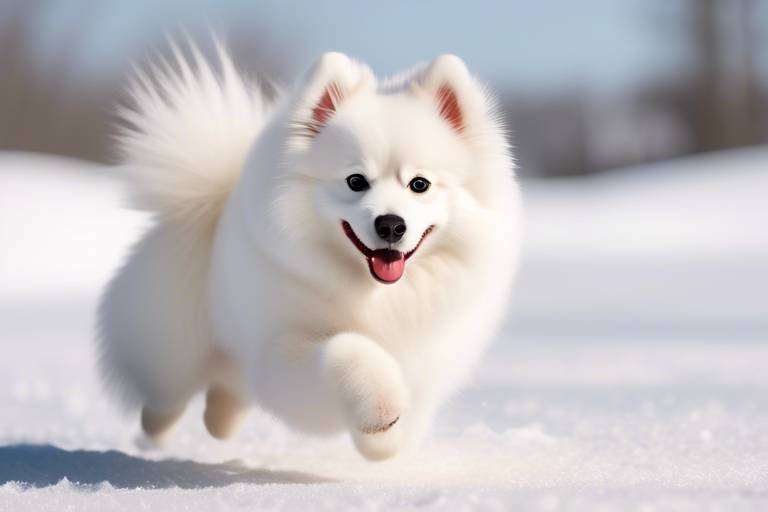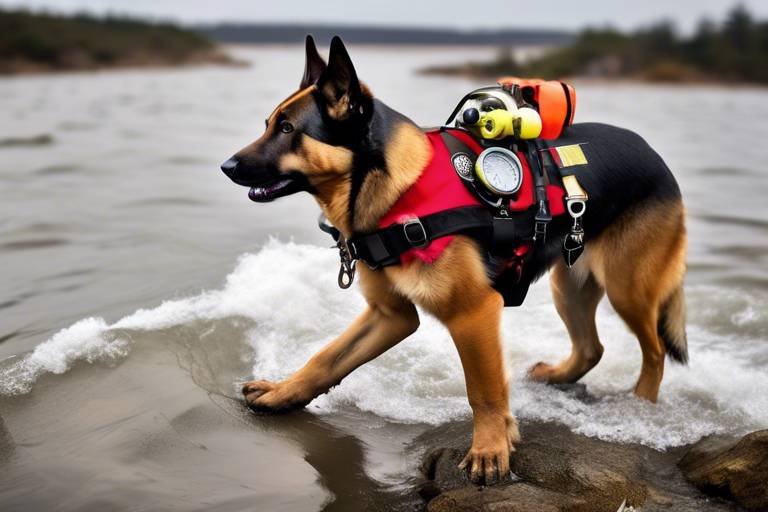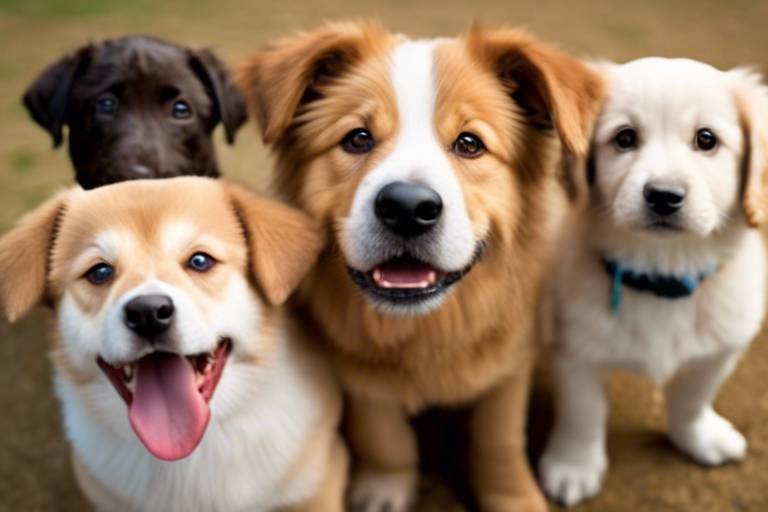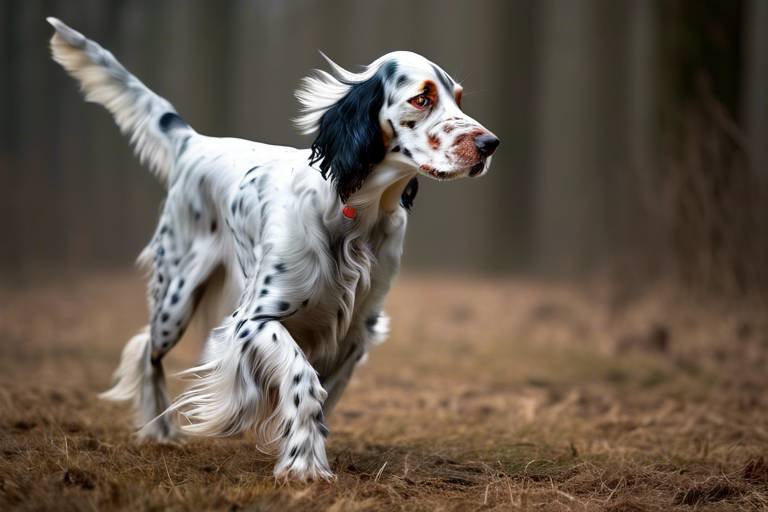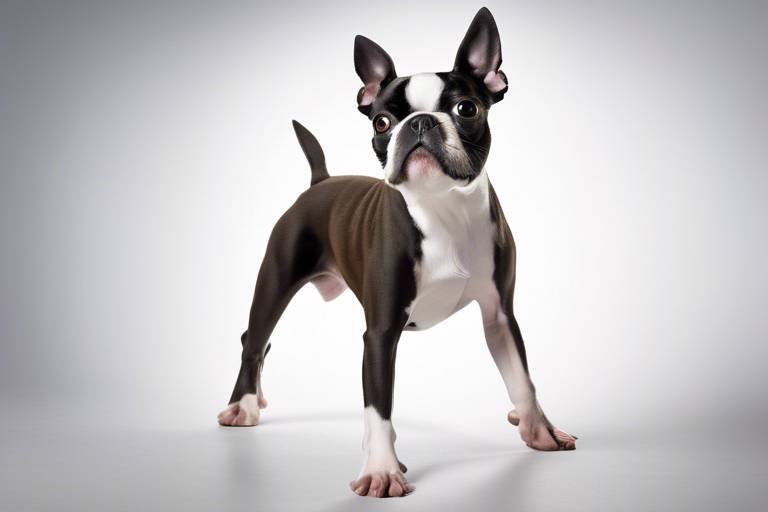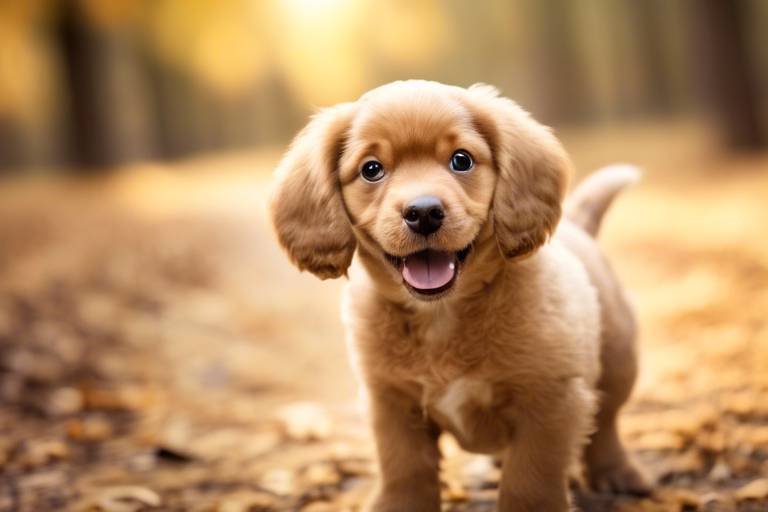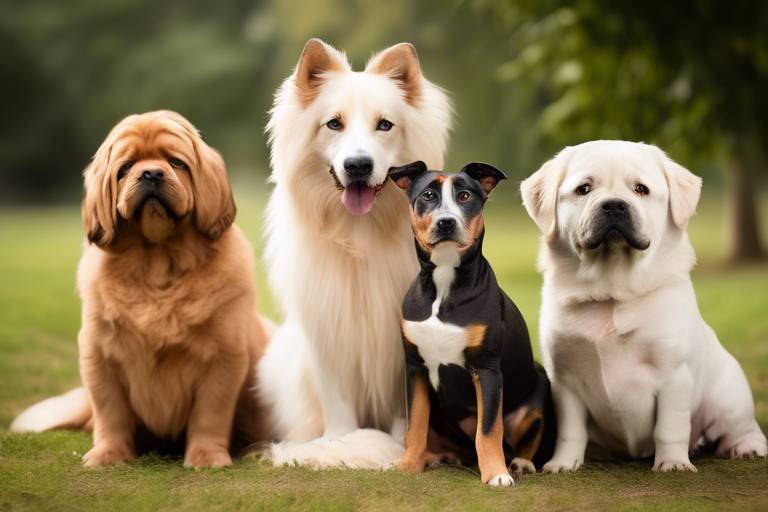How to Train Different Breeds - Breed-Specific Training Tips
This article explores effective training strategies tailored for various dog breeds, highlighting their unique characteristics and needs to ensure successful training outcomes for both owners and their furry companions.
Recognizing the specific traits and temperaments of different dog breeds is crucial for effective training. Each breed is like a unique puzzle piece, with its own quirks, strengths, and weaknesses. For instance, while a Border Collie might thrive on high-energy activities and mental challenges, a Bulldog may prefer a more relaxed approach. Understanding these characteristics influences not just the training methods you choose, but also your expectations. Are you ready for a challenge, or do you need a more laid-back training style? Knowing your dog's breed can help you answer these questions.
Fundamental training techniques are essential for all breeds. Regardless of whether you have a sprightly Jack Russell Terrier or a gentle Newfoundland, establishing a solid foundation in obedience is vital. Techniques such as consistency, patience, and clear communication are key. For example, while a German Shepherd may respond well to structured commands, a Shih Tzu might require more gentle encouragement. The goal is to adapt your approach based on your dog’s individual needs, ensuring that every session is productive and enjoyable.
Positive reinforcement is a powerful training tool that can work wonders across various breeds. Imagine your dog learning a new trick and receiving a tasty treat or a belly rub as a reward. This method fosters a supportive and motivating environment for learning. For example, when training a Labrador Retriever, you might find that they respond enthusiastically to treats, while a Chihuahua may prefer affection as a reward. The key is to find what makes your dog tick and use it to reinforce good behavior.
Using treats and rewards can significantly enhance the training experience. Different breeds may respond better to different types of rewards. For instance, high-energy breeds like Australian Shepherds may benefit from small, high-value treats that keep them engaged, while more laid-back breeds like French Bulldogs might respond well to praise or playtime. It's essential to use rewards strategically; too many treats can lead to weight issues, so balance is crucial. Consider creating a reward chart that outlines what works best for your dog:
| Breed | Preferred Reward | Notes |
|---|---|---|
| Border Collie | High-value treats | Needs mental stimulation |
| Bulldog | Affection | Enjoys relaxed training sessions |
| Beagle | Sniffing games | High prey drive; loves scent work |
Verbal praise is another effective reinforcement method that can make a significant difference in training. Dogs are incredibly perceptive to tone and enthusiasm, and different breeds may respond uniquely to verbal cues. For instance, a Golden Retriever might beam with joy at a cheerful “Good boy!” while a Basenji may require a more subdued approach. The essence lies in your delivery; using a warm and enthusiastic tone can encourage your dog to associate commands with positive experiences.
Socialization is vital for a well-rounded dog. It’s not just about teaching commands; it’s about helping your dog feel comfortable in various environments. For instance, a Rottweiler may require more exposure to different people and pets to prevent territorial behavior, while a Yorkshire Terrier might thrive in social settings but needs guidance to avoid being overwhelmed. Tailoring socialization strategies to your dog's breed can help them develop confidence and adaptability.
Different breeds may exhibit unique behavioral challenges. For example, a Dalmatian might show signs of hyperactivity, while a Great Dane could struggle with anxiety due to their size. Identifying these common issues early on can help you implement tailored solutions effectively. For instance, providing a structured routine and engaging activities can help mitigate hyperactivity, while creating a safe space can ease anxiety.
Anxiety and fear can affect many breeds differently. A Sheltie may become anxious in loud environments, while a Boxer might exhibit fear-based aggression. Recognizing these issues is the first step. Implementing breed-specific strategies, such as gradual desensitization or creating a calming environment, can help manage anxiety effectively.
Aggression can manifest in various forms across different breeds. Identifying aggressive behaviors early is crucial for effective management. For instance, a Pit Bull may display aggression due to fear, while a Chihuahua might act defensively because of their small size. Best practices for addressing aggression include understanding triggers, ensuring proper socialization, and seeking professional help if necessary.
Once basic training is established, advanced techniques can enhance a dog's skills. This section explores specialized training approaches suited for specific breeds, including agility and obedience training. For example, active breeds like Border Collies excel in agility training, while Golden Retrievers can be trained for service roles due to their intelligence and temperament.
Agility training can be particularly beneficial for active breeds. It’s not just a fun activity; it also channels their energy into something productive. Introducing agility training involves setting up an obstacle course and encouraging your dog to navigate through it. Breeds like Australian Shepherds and Jack Russell Terriers thrive in this environment, showcasing their intelligence and agility.
Certain breeds excel in service and therapy roles, providing invaluable support to those in need. Breeds like Labrador Retrievers and Golden Retrievers are often chosen for these roles due to their gentle nature and eagerness to please. Training for these important jobs requires patience and consistency, focusing on socialization, obedience, and specific task training.
- What is the best age to start training my dog? It's best to start training as early as possible, ideally when they are puppies, to instill good habits.
- How long should training sessions last? Training sessions should be short and engaging, typically lasting 5 to 15 minutes, depending on the dog's attention span.
- Can I train my dog at home? Absolutely! Many effective training techniques can be practiced at home with consistency and patience.
- What if my dog doesn't respond to training? If your dog isn't responding, consider adjusting your methods, increasing motivation, or consulting a professional trainer.

[Understanding Breed Characteristics]
Recognizing the specific traits and temperaments of different dog breeds is crucial for effective training. Each breed comes with its own unique characteristics, which can significantly influence how they respond to training techniques. For instance, some breeds, like Border Collies, are known for their intelligence and eagerness to please, making them relatively easy to train. On the other hand, breeds such as Stubborn Bulldogs may require more patience and persistence from their owners. Understanding these nuances can set the stage for a successful training experience.
When you start to train your dog, it's important to consider their breed traits, which can be grouped into a few key categories:
- Energy Level: High-energy breeds like Australian Shepherds need more physical activity and mental stimulation compared to calmer breeds like Newfoundlands.
- Temperament: Some breeds are naturally more social and friendly, while others may be more reserved or protective. For example, Labradors are typically outgoing, whereas Chow Chows can be more aloof.
- Trainability: Certain breeds are more eager to learn and respond quickly to commands. For instance, Golden Retrievers are often highly trainable, while Basenjis may be more independent and stubborn.
Understanding these characteristics enables owners to tailor their training methods accordingly. For instance, a high-energy dog might benefit from training sessions that incorporate play and physical challenges, while a more laid-back breed might do better with shorter, more focused training periods. By adapting your approach to fit your dog's breed-specific needs, you not only enhance their learning experience but also strengthen the bond between you and your furry friend.
Moreover, recognizing how your dog's breed influences their behavior can help in anticipating potential challenges during training. For example, breeds that were originally developed for herding, like Sheepdogs, might display herding instincts, which could lead to chasing or nipping behaviors. Understanding these instincts allows you to proactively address them through targeted training strategies.
In summary, understanding breed characteristics is not just about knowing the general traits of a dog; it's about delving deeper into how these traits affect training and behavior. This knowledge empowers you as a dog owner to create a more effective, enjoyable, and harmonious training experience for both you and your beloved pet.
Q: How can I find out more about my dog's breed characteristics?
A: Researching breed-specific information through reputable sources, such as breed clubs or training organizations, can provide valuable insights into your dog's unique traits.
Q: What if my dog doesn't fit the typical characteristics of their breed?
A: Every dog is an individual, and while breed characteristics can offer guidance, your dog's personality and experiences will shape their behavior. Tailor your training to their specific needs.
Q: Can I train a stubborn breed effectively?
A: Yes! With patience, consistency, and the right techniques, even stubborn breeds can be trained. Consider using positive reinforcement and engaging training methods to keep their interest.

[Basic Training Techniques]
When it comes to training your furry friend, understanding basic training techniques is essential for all dog breeds. These techniques lay the groundwork for a well-behaved companion, regardless of whether you have a playful Beagle or a dignified Great Dane. The core methods can be adapted based on the unique needs of each breed, ensuring that your training sessions are both effective and enjoyable.
One of the most fundamental aspects of training is establishing a strong bond with your dog. This bond is built on trust and respect, which can be fostered through consistent training practices. Think of it as a dance: both you and your dog need to learn the steps together. By using clear commands and consistent cues, you can guide your dog through the learning process. Remember, patience is key; every dog learns at their own pace, and it’s essential to adjust your expectations accordingly.
Another critical technique is positive reinforcement. This approach involves rewarding your dog for good behavior, which encourages them to repeat that behavior in the future. For instance, if your dog sits on command, offering a treat or verbal praise reinforces that action. Positive reinforcement creates a supportive environment where your dog feels motivated to learn. To effectively implement this technique, consider the following:
| Reward Type | Best Breeds | Notes |
|---|---|---|
| Treats | All breeds | Use small, tasty treats for quick rewards. |
| Toys | Active breeds (e.g., Border Collies) | Use toys for play-based rewards. |
| Affection | All breeds | Physical affection works wonders for bonding. |
When using treats, it’s crucial to choose the right type for your dog. Some breeds may have specific dietary restrictions or preferences, so it’s always a good idea to experiment a little. For instance, while Golden Retrievers often respond well to a variety of treats, a French Bulldog might prefer soft, chewy options due to their sensitive teeth.
Verbal praise is another effective reinforcement method that can’t be overlooked. Dogs are social animals, and they thrive on positive interaction with their owners. The tone of your voice can significantly impact how your dog perceives your praise. A high-pitched, enthusiastic tone can make your dog feel excited and rewarded, while a calm, soothing voice can help them relax during training. Different breeds may respond differently to verbal cues; for example, Herding breeds like Australian Shepherds may be more attuned to your voice than more independent breeds like Chow Chows.
In addition to these techniques, consistency is vital. Dogs thrive on routine, and establishing a regular training schedule can help reinforce learning. Try to keep training sessions short and fun—around 5 to 10 minutes—especially for younger dogs or those with shorter attention spans. You can gradually increase the duration as your dog becomes more comfortable with the commands.
Lastly, socialization is an often-overlooked aspect of basic training that can significantly affect your dog’s behavior. Exposing your dog to various environments, people, and other animals helps them become well-rounded and confident. This is especially important for breeds that can be more reserved or anxious. Remember, a well-socialized dog is not only easier to train but also a joy to have around!
In summary, mastering basic training techniques involves understanding your dog’s unique needs, using positive reinforcement, and maintaining consistency. By doing so, you’ll not only teach your dog obedience but also strengthen the bond between you and your furry companion.
- What is the best age to start training my dog? It's best to start training as early as possible, typically around 8 weeks old, but it's never too late to train a dog.
- How long should training sessions last? Short sessions of 5-10 minutes are ideal, especially for puppies.
- Can I use my dog's favorite toy as a reward? Absolutely! Using toys can be a great motivator, especially for active breeds.
[Positive Reinforcement]
When it comes to training our beloved dogs, positive reinforcement stands out as one of the most effective and humane methods available. This approach revolves around rewarding desirable behaviors, which encourages dogs to repeat those actions. Imagine trying to teach a child to ride a bike; would you rather praise them for their efforts or scold them when they fall? The same principle applies to our furry companions. By focusing on what they do right, we create a more enjoyable learning environment for both the dog and the owner.
One of the beautiful aspects of positive reinforcement is its adaptability across different breeds. For instance, a high-energy breed like a Border Collie may respond exceptionally well to treats and playtime as rewards, while a more laid-back breed like a Bulldog might prefer gentle praise and belly rubs. Understanding what motivates your dog is key to successful training. Here’s a quick look at some common rewards that can be used based on breed characteristics:
| Breed Type | Preferred Rewards |
|---|---|
| Working Breeds (e.g., German Shepherds) | High-value treats, praise, and playtime |
| Sporting Breeds (e.g., Labrador Retrievers) | Active play, fetch games, and treats |
| Toy Breeds (e.g., Chihuahuas) | Verbal praise, gentle petting, and small treats |
| Hound Breeds (e.g., Beagles) | Food rewards, scent games, and social play |
Implementing positive reinforcement is not just about giving treats; it’s also about timing and consistency. The reward must come immediately after the desired behavior to help your dog make the connection. For example, if your dog sits on command, rewarding them right away with a treat or praise reinforces that good behavior. Over time, their understanding deepens, and they’ll be more likely to repeat the action without prompting.
Moreover, it’s essential to keep the training sessions short and engaging. Dogs, like humans, can lose focus if sessions drag on too long. A good rule of thumb is to keep training sessions to around 5-10 minutes, especially for younger dogs. This way, they remain excited and eager to learn, making the entire experience more enjoyable.
In addition to treats and praise, incorporating playtime as a reward can be particularly effective, especially for breeds that thrive on physical activity. For instance, if your dog successfully completes a trick, follow up with a quick game of tug-of-war or a fun fetch session. This not only reinforces the behavior but also strengthens the bond between you and your dog.
In conclusion, positive reinforcement is a powerful tool in dog training that can lead to remarkable results. By understanding your dog's unique motivations and applying the right techniques, you can create a supportive training environment that fosters learning and strengthens your relationship. Remember, the goal is to make training a fun and rewarding experience for both you and your furry friend!
- What is positive reinforcement? Positive reinforcement is a training method that rewards desirable behaviors to encourage their repetition.
- How do I know what rewards to use? Observe what excites your dog—treats, toys, or praise—and use those as rewards during training.
- Can I use positive reinforcement for all breeds? Yes! Positive reinforcement can be adapted to suit the unique traits and preferences of any breed.
- How long should training sessions last? Keep sessions short, ideally between 5-10 minutes, to maintain your dog's focus and enthusiasm.
[Treats and Rewards]
When it comes to training our furry friends, treats and rewards play a pivotal role in shaping their behavior and reinforcing positive actions. Just like humans love a little incentive to reach their goals, dogs thrive on the same concept. Imagine this: you’re at work, and your boss promises a bonus for meeting your targets. Wouldn’t that motivate you to give your best? Similarly, using treats effectively during training can create a powerful bond between you and your dog, making the learning process enjoyable and rewarding.
However, not all treats are created equal. It’s essential to choose the right types of rewards that resonate with your dog's unique preferences. For instance, some dogs might go crazy for crunchy biscuits, while others might prefer soft, chewy treats. Understanding what excites your dog can make all the difference. Here’s a quick table to help you identify some popular treat types and their ideal uses:
| Treat Type | Best For | Notes |
|---|---|---|
| Soft Chewy Treats | Puppies and older dogs | Easy to chew and digest |
| Crunchy Biscuits | Active dogs | Great for dental health |
| Freeze-Dried Meat | High-energy breeds | High protein, very enticing |
| Fruits and Vegetables | Health-conscious owners | Low-calorie options |
Moreover, it’s not just about the type of treat; it’s also about the timing and delivery. Timing is crucial when rewarding your dog. The reward should come immediately after the desired behavior to help them make the connection. For example, if your dog sits on command and you wait too long before giving them a treat, they might not associate the treat with the action. Instead, they could think they’re being rewarded for something else entirely, like simply being adorable!
Another aspect to consider is the quantity of treats. While it’s tempting to shower your dog with goodies, moderation is key. Too many treats can lead to weight gain and health issues. A good rule of thumb is that treats should make up no more than 10% of your dog’s daily caloric intake. To keep track, you might want to measure your dog’s food portions and adjust accordingly based on the number of treats given during training sessions.
Lastly, don’t underestimate the power of variety. Just like we enjoy a mix of flavors in our meals, dogs appreciate a range of treats too. Rotating between different types of rewards can keep your dog engaged and eager to learn. You could even incorporate some of their regular kibble as a treat during training sessions, turning mealtime into a fun learning experience!
In conclusion, using treats and rewards effectively is a game changer in dog training. By understanding your dog’s preferences, timing your rewards, and maintaining moderation, you can create a positive training environment that not only fosters learning but also strengthens your bond. Remember, a happy dog is a well-trained dog!
[Verbal Praise]
When it comes to training your dog, verbal praise is an incredibly powerful tool that often goes underutilized. Think of it as the fuel that drives your dog's motivation engine. Dogs, much like humans, thrive on positive feedback. They want to know when they're doing a good job, and your voice can be the most encouraging sound to their ears. But here’s the catch: not all breeds respond the same way to verbal cues. Some breeds may perk up at a simple, enthusiastic “Good boy!” while others may need a bit more flair in your tone to really get excited.
So, how do you make the most out of verbal praise? First off, timing is everything. You want to deliver your praise immediately after your dog performs the desired behavior. This creates a clear connection in their mind between the action and the reward. For instance, if your Labrador sits on command, give them that enthusiastic “Yes!” or “Good job!” the moment their bottom hits the ground. This immediate feedback helps reinforce the behavior, making it more likely they will repeat it in the future.
Moreover, the tone of your voice can significantly impact how your dog perceives your praise. A high-pitched, cheerful tone can excite breeds like Beagles or Corgis, while a calm and soothing voice may resonate better with more sensitive breeds like Greyhounds or Shih Tzus. It’s all about knowing your pup and adjusting your approach accordingly. If you’re unsure, try experimenting with different tones and watch how your dog reacts. It’s almost like a game of trial and error, and the rewards can be immensely satisfying.
Additionally, consider using verbal praise in conjunction with other forms of reinforcement. For instance, when your dog successfully completes a command, follow up your enthusiastic praise with a treat or a favorite toy. This combination can create a more robust learning experience, making your dog associate multiple positive outcomes with their good behavior. You could even create a little praise ritual where you mix verbal praise with physical affection, like petting or belly rubs, to further strengthen your bond.
Remember, consistency is key. Make sure to use the same phrases and tone during training sessions, so your dog can easily recognize and associate the words with positive actions. Over time, your dog will become more attuned to your verbal cues, which can make training sessions smoother and more enjoyable for both of you.
In summary, verbal praise is not just a simple “good job”; it’s a dynamic and essential part of your training toolbox. By understanding how different breeds respond to verbal cues and tailoring your approach, you can create a more effective and enjoyable training experience. So, the next time you’re working with your furry friend, don’t underestimate the power of your voice—it could be the secret ingredient to unlocking their full potential!
- What is the best way to use verbal praise during training? Timing is crucial; praise your dog immediately after they perform the desired behavior.
- Does the tone of my voice matter? Absolutely! Different breeds respond better to different tones, so adjust your voice accordingly.
- Can I combine verbal praise with treats? Yes! Using both can enhance the training experience and reinforce good behavior.
- How can I tell if my dog is responding well to verbal praise? Watch their body language; if they seem excited or eager to engage, you’re on the right track!
[Socialization Strategies]
Socialization is a crucial aspect of a dog's development, and it's particularly important to tailor these strategies to the unique needs of different breeds. Just like humans, dogs thrive in environments where they feel comfortable and confident. Think of socialization as a bridge that connects your furry friend to the world around them. It helps them navigate various situations, from meeting new people to encountering other animals. Each breed comes with its own set of instincts and temperaments, which means that the approach to socialization should vary accordingly.
For instance, some breeds like Golden Retrievers are naturally friendly and sociable, which means they may adapt quickly to new experiences. In contrast, breeds like Chihuahuas might require a more gradual introduction to unfamiliar environments, as they can be more cautious or even fearful. Therefore, understanding your dog's breed characteristics is the first step in developing effective socialization strategies.
One effective method for socialization is to expose your dog to a variety of settings and situations. This could include:
- Visits to dog parks
- Interactions with other dogs
- Meeting new people, including children and elderly individuals
- Experiencing different environments, like busy streets or quiet parks
Incorporating these experiences into your dog's routine will help them build confidence and learn how to behave appropriately in various scenarios. Remember, it's essential to monitor your dog's reactions during these interactions. If they seem overwhelmed or anxious, take a step back and allow them to acclimate at their own pace.
Another key aspect of socialization is positive reinforcement. By rewarding your dog with treats or praise when they successfully interact with new stimuli, you create a positive association with those experiences. This is particularly effective for breeds that may be more sensitive or reserved. For example, if your timid breed approaches a new dog or person, shower them with affection and a tasty treat to reinforce their bravery.
Additionally, enrolling your dog in socialization classes can be a game changer. These classes provide a controlled environment where dogs can interact with their peers under the guidance of professional trainers. It’s a perfect opportunity for your dog to learn appropriate social skills while you gain valuable insights into their behavior. Not only do these classes promote socialization, but they also strengthen the bond between you and your furry companion.
In summary, effective socialization strategies are essential for helping your dog thrive in different environments. By understanding breed-specific needs, exposing your dog to various experiences, and utilizing positive reinforcement, you can ensure your dog grows into a well-adjusted and confident companion. Remember, the goal is to make socialization a fun and rewarding experience for both you and your dog!
Q: How early should I start socializing my puppy?
A: The critical period for socialization is between 3 to 14 weeks of age. However, socialization should continue throughout your dog's life.
Q: What if my dog is fearful of new experiences?
A: Take it slow! Gradually expose your dog to new situations and use positive reinforcement to encourage them.
Q: Can adult dogs be socialized?
A: Absolutely! While it may take more time and patience, adult dogs can learn to adapt to new experiences.
Q: Are there specific socialization techniques for different breeds?
A: Yes, understanding your dog's breed characteristics can help tailor your approach to socialization. For example, more reserved breeds may need gentler introductions.
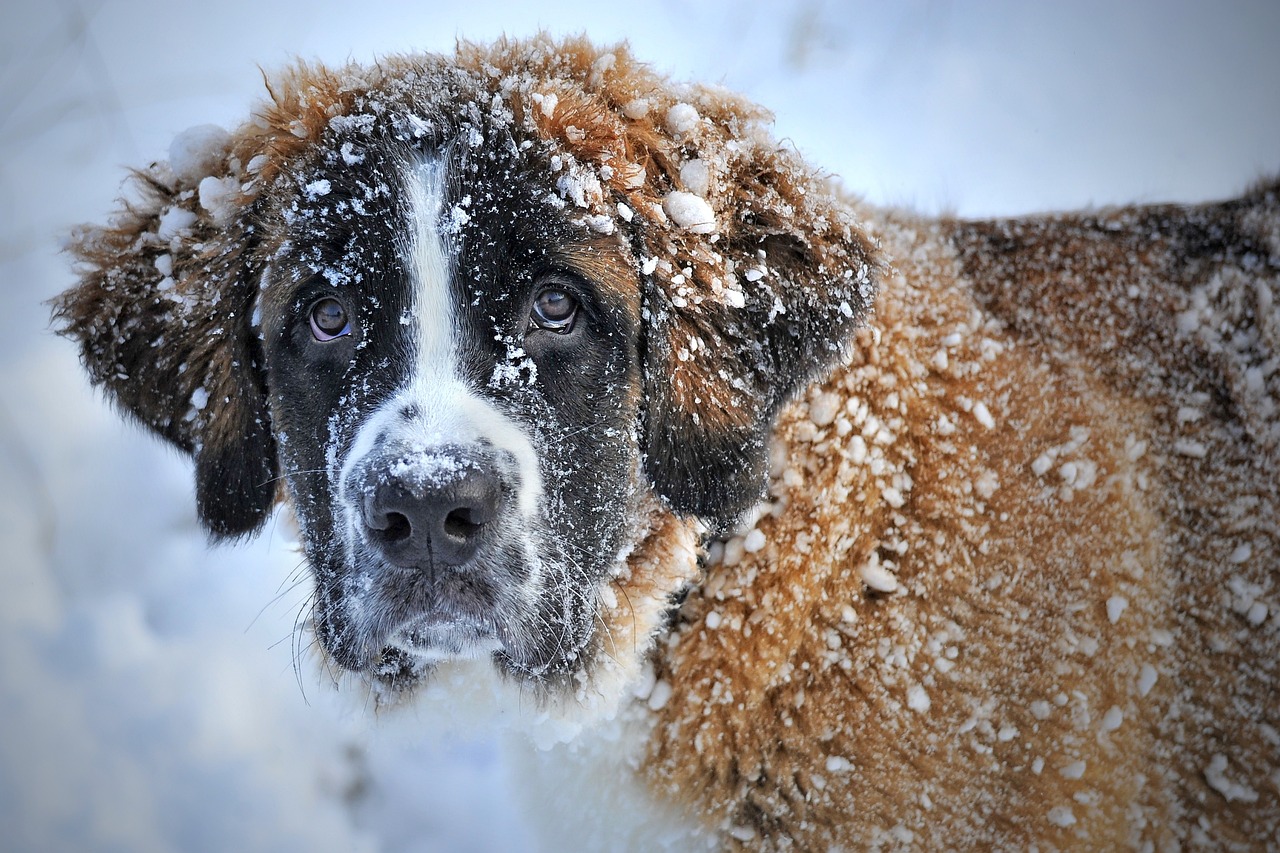
[Common Behavioral Issues]
Every dog is unique, and with that uniqueness comes a variety of behavioral challenges that can arise during their training journey. Understanding these common behavioral issues is essential for dog owners, as it allows them to tailor their training approaches to meet their furry friends' specific needs. Whether you have a feisty terrier or a gentle giant, recognizing the signs of behavioral problems can lead to effective solutions and a harmonious relationship.
One of the most prevalent issues across various breeds is anxiety and fear. Many dogs experience anxiety due to changes in their environment, loud noises, or even separation from their owners. For instance, breeds like Border Collies and German Shepherds are known for their sensitivity, which can manifest as fearfulness in unfamiliar situations. Identifying the triggers of anxiety is crucial. Owners should observe their dogs closely and note when anxiety arises, enabling them to implement targeted strategies to alleviate these feelings.
Another common concern is aggression, which can take many forms, including fear-based aggression, territorial aggression, or even play aggression. Breeds such as Rottweilers and Pit Bulls may exhibit aggressive tendencies if not properly socialized from a young age. Understanding the root cause of aggression is vital. For example, fear can drive a dog to act aggressively as a defense mechanism. Owners should look for warning signs, such as growling or stiff body language, and consult with a professional trainer if necessary to develop a comprehensive management plan.
To make this concept clearer, here’s a table summarizing some common behavioral issues and their potential solutions:
| Behavioral Issue | Common Breeds Affected | Suggested Solutions |
|---|---|---|
| Anxiety and Fear | Border Collies, German Shepherds | Desensitization, counter-conditioning, calming aids |
| Aggression | Rottweilers, Pit Bulls | Socialization, professional training, behavior modification |
| Excessive Barking | Beagles, Chihuahuas | Training commands, mental stimulation, distraction techniques |
Additionally, some breeds may struggle with excessive barking, which can be particularly challenging for owners. Breeds like Beagles and Chihuahuas are known for their vocal tendencies. Understanding the motivation behind the barking—be it boredom, anxiety, or a desire for attention—can help owners address the issue effectively. Training commands such as "quiet" can be reinforced with positive rewards, creating a more peaceful environment.
In conclusion, recognizing and addressing these common behavioral issues is a critical aspect of dog ownership. By understanding the specific needs of different breeds and implementing tailored training strategies, owners can foster a well-behaved and happy companion. Remember, patience and consistency are key! With the right tools and knowledge, you can turn behavioral challenges into opportunities for growth and bonding with your furry friend.
- What should I do if my dog shows signs of aggression? - It's essential to consult with a professional trainer who can help you develop a behavior modification plan.
- How can I help my anxious dog? - Gradual desensitization to their triggers and providing a safe space can significantly help reduce anxiety.
- Is excessive barking a sign of a behavioral issue? - Yes, it can indicate boredom, anxiety, or a need for attention. Training and mental stimulation can help manage this behavior.
[Anxiety and Fear]
When it comes to our furry friends, anxiety and fear are common challenges that many dog owners face. Different breeds can exhibit these feelings in various ways, often influenced by their unique temperaments and backgrounds. For instance, a Border Collie may show anxiety through excessive barking or pacing, while a Chihuahua might become overly clingy or defensive. Understanding how anxiety manifests in your specific breed is the first step towards effective management.
Recognizing the signs of anxiety is crucial. Dogs may display behaviors such as:
- Destructive behavior: Chewing furniture or digging at doors.
- Excessive barking: Vocalizing more than usual, especially in response to stimuli.
- Shaking or trembling: Physical signs of distress that are hard to miss.
- Avoidance behaviors: Hiding or attempting to escape from certain situations.
Once you've identified the signs, it's essential to develop a tailored approach to help your dog cope with anxiety. Here are some breed-specific strategies to consider:
| Breed | Common Signs of Anxiety | Recommended Strategies |
|---|---|---|
| German Shepherd | Restlessness, barking | Structured exercise, obedience training |
| Beagle | Howling, destructive chewing | Interactive toys, socialization |
| Poodle | Shaking, clinginess | Calm environments, gradual exposure to stressors |
Creating a safe and comforting environment is another key element in managing anxiety. This can include establishing a consistent routine, providing a designated safe space for your dog, and using calming aids like thunder shirts or pheromone diffusers. Additionally, engaging in regular exercise can significantly reduce anxiety levels, as it helps to release pent-up energy and stress.
It's also important to note that some breeds are more prone to anxiety due to their sensitive nature. For instance, Whippets and Greyhounds can be particularly sensitive to loud noises or chaotic environments. Understanding your dog's background and personality can help you anticipate their reactions and prepare accordingly.
If anxiety persists or worsens, consulting a professional dog trainer or a veterinarian can provide further insights and potential treatment options. They may recommend behavioral therapy or, in some cases, medication to help your furry friend feel more at ease in their environment.
In conclusion, while anxiety and fear can be challenging for both dogs and their owners, recognizing the signs and implementing breed-specific strategies can significantly improve your dog's quality of life. Remember, patience and understanding are key. With the right approach, you can help your dog navigate their fears, leading to a happier and healthier life together.
- What are the common signs of anxiety in dogs? - Signs include barking, destructive behavior, shaking, and avoidance.
- How can I help my anxious dog? - Create a safe environment, establish a routine, and consider professional help if needed.
- Are certain breeds more prone to anxiety? - Yes, some breeds like Whippets and Greyhounds can be more sensitive to stressors.
- Is medication necessary for anxious dogs? - Medication is sometimes recommended, but it should be discussed with a veterinarian.
[Aggression Management]
Aggression in dogs can be a serious concern for owners, and it's essential to understand that different breeds may exhibit aggressive behaviors for various reasons. Recognizing these triggers is vital for effective management. For instance, some breeds may show aggression due to fear, while others may be more territorial. Understanding the underlying causes of aggression helps in tailoring a response that is appropriate for the specific breed.
When addressing aggression, the first step is to identify the type of aggression your dog is displaying. Common forms include fear-based aggression, territorial aggression, and protective aggression. Each type requires a unique approach. For example, fear-based aggression often stems from a lack of socialization or previous negative experiences, making it crucial to gradually expose the dog to new environments and situations in a controlled manner.
Additionally, positive reinforcement can be a powerful tool in managing aggression. Instead of punishing aggressive behavior, reward calm and non-aggressive actions. This method not only reinforces good behavior but also helps build a trusting relationship between the dog and its owner. For instance, if your dog remains calm in a situation that usually triggers aggression, offer a treat or verbal praise. This encourages the dog to associate positive experiences with previously stressful situations.
Consistency is key in aggression management. Establishing a routine and clear boundaries can help your dog understand what is expected of them. If your dog exhibits aggressive behavior, it’s important to remain calm and avoid reacting with anger, as this can escalate the situation. Instead, redirect your dog’s attention to a more appropriate behavior or command, using techniques like distraction or obedience commands.
In some cases, consulting a professional dog trainer or behaviorist is advisable, especially if the aggression is severe or poses a danger to others. They can provide tailored strategies and training plans that consider the dog's breed, temperament, and individual history. Remember, aggression is not a trait that can be ignored; it requires attention and proper management to ensure the safety of both the dog and those around them.
- What are the signs of aggression in dogs? Look for body language such as growling, baring teeth, stiff posture, or raised hackles. These can indicate discomfort or aggression.
- Can aggression be trained out of a dog? Yes, with consistent training and proper management strategies, many dogs can learn to modify their aggressive behaviors.
- Is it safe to keep an aggressive dog? It can be safe if the owner is knowledgeable about the dog's triggers and implements effective training and management strategies.
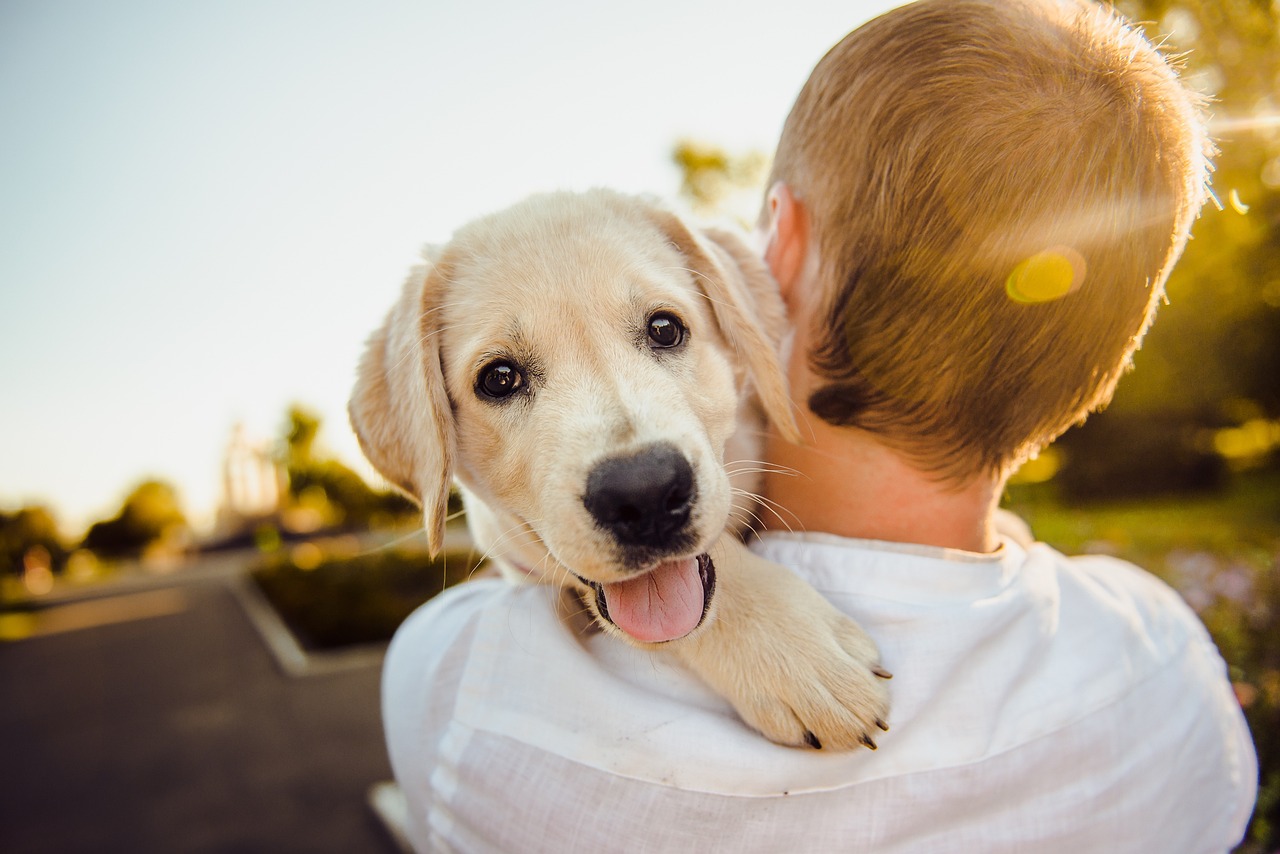
[Advanced Training Techniques]
Once you've laid down the groundwork with basic training techniques, it's time to kick it up a notch with advanced training techniques. These methods not only enhance your dog’s skills but also provide a deeper bond between you and your furry friend. Every breed has its own strengths and weaknesses, and understanding these can help you tailor advanced training to fit their unique characteristics. For instance, high-energy breeds like Border Collies thrive on agility training, while more patient breeds might excel in service and therapy roles. So, how do you know where to start?
One of the most exciting aspects of advanced training is agility training. This method is fantastic for active breeds that require both physical and mental stimulation. Think of agility training as an obstacle course for dogs, where they navigate through tunnels, jumps, and weave poles. It’s not just about speed; it’s about building confidence and teamwork. For example, a Labrador Retriever, known for its intelligence and enthusiasm, can really shine in agility courses, showcasing their natural athleticism and eagerness to please. If you're considering agility training, start with simple courses and gradually increase the complexity as your dog gains confidence and skill.
Moreover, service and therapy training is another advanced technique that caters to specific breeds known for their gentle temperament and intelligence. Breeds like Golden Retrievers and Poodles often excel in these roles, providing comfort and assistance to those in need. Training for these roles requires patience and consistency, as the dog must learn to remain calm and focused in potentially stressful situations. The training process typically involves exposing the dog to various environments and scenarios, ensuring they can adapt and respond appropriately. This not only benefits the dog but also enriches the lives of those they assist.
To give you a clearer picture, here’s a simple table outlining some advanced training techniques and the breeds that typically excel in them:
| Training Technique | Ideal Breeds |
|---|---|
| Agility Training | Border Collies, Australian Shepherds, Jack Russell Terriers |
| Service Dog Training | Golden Retrievers, Labrador Retrievers, Poodles |
| Therapy Dog Training | Beagles, Cavalier King Charles Spaniels, Newfoundlands |
In conclusion, advanced training techniques are not just about teaching your dog to do tricks; they are about enhancing their natural abilities and building a stronger relationship. By focusing on breed-specific training methods, you can ensure that your dog not only learns effectively but also enjoys the process. So, whether you're looking to navigate an agility course or train your dog to provide comfort as a therapy animal, remember that the journey is just as important as the destination.
Q: How do I know if my dog is ready for advanced training?
A: If your dog has mastered basic commands and shows enthusiasm during training sessions, they are likely ready for advanced techniques.
Q: Can any breed participate in agility training?
A: While many breeds can participate, those with higher energy levels and agility, such as Border Collies and Australian Shepherds, tend to excel.
Q: What are the benefits of service and therapy dog training?
A: These training programs not only enhance the dog's skills but also provide invaluable support to individuals in need, improving their quality of life.
[Agility Training]
Agility training is not just a fun activity; it's a fantastic way to bond with your dog while also challenging them physically and mentally. This type of training is particularly beneficial for active breeds such as Border Collies, Australian Shepherds, and Jack Russell Terriers, who thrive on both physical exertion and mental stimulation. Imagine your dog zipping through tunnels, weaving between poles, and jumping over hurdles—it's like watching a furry athlete in action!
When introducing agility training, it’s essential to start with the basics. Begin by familiarizing your dog with the various obstacles they will encounter. You can set up a simple course in your backyard or even join a local agility club. The key is to keep the experience positive and fun. Use treats and verbal praise to encourage your dog as they navigate the course. This positive reinforcement not only boosts their confidence but also strengthens your bond.
Here are some common obstacles you might include in an agility course:
- Tunnels: Dogs love to dash through tunnels, and it helps them develop their confidence.
- Weave Poles: These require focus and coordination, perfect for sharpening their agility skills.
- Jumps: Simple jumps can be adjusted in height as your dog becomes more proficient.
- Dog Walks: These elevated planks teach balance and coordination.
As your dog becomes more comfortable with the obstacles, you can gradually increase the complexity of the course. This not only keeps things interesting but also challenges your dog to think critically during their runs. Remember, patience is key! Some dogs may take longer to learn specific skills, and that’s perfectly okay. Celebrate small victories along the way, whether it’s completing a jump correctly or navigating a tunnel without hesitation.
Moreover, agility training is not just about physical prowess; it also enhances your dog's obedience and focus. During training sessions, your dog learns to listen to your commands amidst distractions, which is invaluable in everyday situations. This heightened level of concentration can lead to improved behavior in other areas of training as well.
For those interested in taking agility training to the next level, consider entering competitions. These events can be incredibly rewarding and provide a fantastic opportunity for you and your dog to showcase your hard work and dedication. Plus, it’s a great way to meet other dog enthusiasts and share tips and experiences!
In summary, agility training is a dynamic and engaging way to keep your dog active and mentally stimulated. By incorporating various obstacles and maintaining a positive training environment, you can help your dog develop essential skills while having a blast together. So, grab some treats, set up a course, and watch your furry friend shine!
Q: What breeds are best suited for agility training?
A: While many breeds can participate, active and intelligent breeds like Border Collies, Australian Shepherds, and Labrador Retrievers excel in agility training due to their energy and eagerness to learn.
Q: How long should agility training sessions last?
A: Training sessions should be kept short and engaging, ideally around 15-30 minutes, to maintain your dog's focus and enthusiasm.
Q: Can older dogs participate in agility training?
A: Yes, older dogs can participate, but it’s essential to consult with a veterinarian to ensure they are physically capable and to modify the course to suit their abilities.
Q: What equipment do I need for agility training?
A: Basic agility equipment includes jumps, tunnels, weave poles, and dog walks. Many of these can be purchased or even made at home!
[Service and Therapy Training]
When it comes to service and therapy training, certain dog breeds naturally shine due to their temperament, intelligence, and eagerness to please. Breeds such as Golden Retrievers, Labrador Retrievers, and German Shepherds are often at the forefront of this type of training. These breeds possess a unique combination of traits that make them ideal candidates for roles that require empathy, reliability, and a strong work ethic. But what exactly does this training entail?
Service dogs are trained to assist individuals with disabilities, providing crucial support in daily activities. On the other hand, therapy dogs offer comfort and emotional support, often visiting hospitals, schools, and nursing homes to uplift spirits. The training for both roles varies slightly, but the core principles remain the same: obedience, socialization, and specialized skills.
To begin with, the training process for service and therapy dogs should start at a young age. Early socialization is critical; it helps dogs become accustomed to various environments and situations. For instance, exposing them to different sounds, people, and settings can significantly improve their adaptability. A well-socialized dog will be more confident and less likely to react negatively in unfamiliar situations.
Once basic obedience is established, the next step involves teaching specific tasks. For service dogs, this could include retrieving items, guiding visually impaired individuals, or alerting their owners to medical issues. Therapy dogs, however, focus more on developing a calm demeanor and the ability to interact positively with people. This often includes practicing gentle greetings and learning to remain calm in busy environments.
One crucial aspect of training is the use of positive reinforcement. This method encourages dogs to associate good behavior with rewards, such as treats or praise. For example, when a dog successfully performs a task, immediate verbal praise or a small treat can reinforce that behavior, making it more likely they will repeat it in the future. This approach not only motivates the dog but also strengthens the bond between the dog and its handler.
It's also essential to consider that different breeds may respond uniquely to training techniques. For instance, while a Labrador may thrive on enthusiastic praise, a more sensitive breed like a Shih Tzu might benefit from a gentler approach. Tailoring your training methods to suit the individual dog's personality can lead to more effective outcomes.
As the training progresses, regular assessments are vital to ensure that the dog is meeting the necessary standards for service or therapy work. This can include formal evaluations or practical tests in real-life situations. Consistency in training sessions is key; short, frequent sessions tend to be more effective than longer, sporadic ones. This keeps the dog engaged and eager to learn.
| Breed | Ideal Traits for Service/Therapy Work |
|---|---|
| Golden Retriever | Friendly, intelligent, and eager to please |
| Labrador Retriever | Affectionate, highly trainable, and sociable |
| German Shepherd | Loyal, protective, and versatile |
| Beagle | Curious, friendly, and good-natured |
In conclusion, training a dog for service or therapy work requires a thoughtful approach that respects the unique characteristics of the breed. By focusing on early socialization, positive reinforcement, and tailored training methods, owners can help their dogs excel in these rewarding roles. Not only do these dogs provide invaluable support to their handlers, but they also enrich the lives of those they serve, creating a profound bond that transcends mere companionship.
- What breeds are best for service and therapy work? Breeds like Golden Retrievers, Labrador Retrievers, and German Shepherds are commonly used due to their temperament and trainability.
- How long does it take to train a service dog? Training can take anywhere from 6 months to 2 years, depending on the tasks required and the dog's individual learning pace.
- Can any dog be trained as a therapy dog? While many dogs can become therapy dogs, they must have a calm demeanor and be comfortable in various social situations.
- Is positive reinforcement necessary for training? Yes, positive reinforcement is highly effective in encouraging desired behaviors and building a strong bond between the dog and handler.
Frequently Asked Questions
- What are some effective training methods for different dog breeds?
Training methods can vary significantly based on a dog's breed. For example, herding breeds like Border Collies thrive with structured activities and agility training, while toy breeds may respond better to positive reinforcement and gentle handling. Understanding your dog's unique characteristics is key to selecting the most effective training approach.
- How important is socialization for my dog?
Socialization is crucial for all dogs, but it’s especially important for breeds that tend to be more anxious or aggressive. Early exposure to different environments, people, and other animals helps build confidence and adaptability. It’s like teaching a child to navigate the world; the more experiences they have, the better they adapt!
- What should I do if my dog shows signs of anxiety?
If your dog is displaying anxiety, it's important to first identify the triggers. Each breed may react differently, so tailored strategies are essential. For some, calming techniques like creating a safe space or using anxiety wraps can help, while others may benefit from professional training or behavior modification programs.
- Are treats necessary for training?
Treats can be a fantastic motivator during training, but they aren't the only option. Many dogs respond well to verbal praise and affection. The key is to find what motivates your dog the most and use it consistently to reinforce positive behaviors.
- Can all breeds participate in agility training?
While agility training is particularly beneficial for active breeds, many dogs can participate regardless of their breed. However, it's essential to consider your dog's physical abilities and temperament. Start slowly and ensure the training is enjoyable to avoid overwhelming your furry friend.
- How do I address aggression in my dog?
Addressing aggression requires understanding the underlying cause. Different breeds may exhibit aggressive behavior for various reasons, such as fear or territorial instincts. Consulting a professional trainer who specializes in behavioral issues can provide tailored strategies to manage and reduce aggression effectively.
- What type of training is best for service dogs?
Service dogs require extensive training that focuses on specific tasks to assist their handlers. Breeds known for their intelligence and calm demeanor, like Labradors or Golden Retrievers, often excel in these roles. Training should include obedience, socialization, and task-specific skills to ensure they can perform their duties reliably.


